This post may contain affiliate links. Read our disclosure policy.
Cakes or cupcakes that sink in the middle during or after baking can be one of The. Most. Frustrating. things to happen in the kitchen.

You think you’ve nailed the recipe. You’ve spent time and money on mixing up the batter. You’re excited to decorate your pretty, perfectly-level cake or beautifully shaped cupcakes, and BAM! Suddenly your cake or cupcakes have a big ol’ crater in the middle.
You’re left wondering, “Why? What happened? What went wrong?”

Free Buttercream Guide!
Frost your cakes and cupcakes perfectly with our Best Buttercream Guide. Trusted by 50,000+ home bakers.
In this article, I’ll explain eight of the most common reasons why your cake or cupcakes may have sunk and the science behind why this happened.
I will also teach you how to prevent sinkage and give you some great options for salvaging your sunken cakes and cupcakes, so it’s not a total loss.
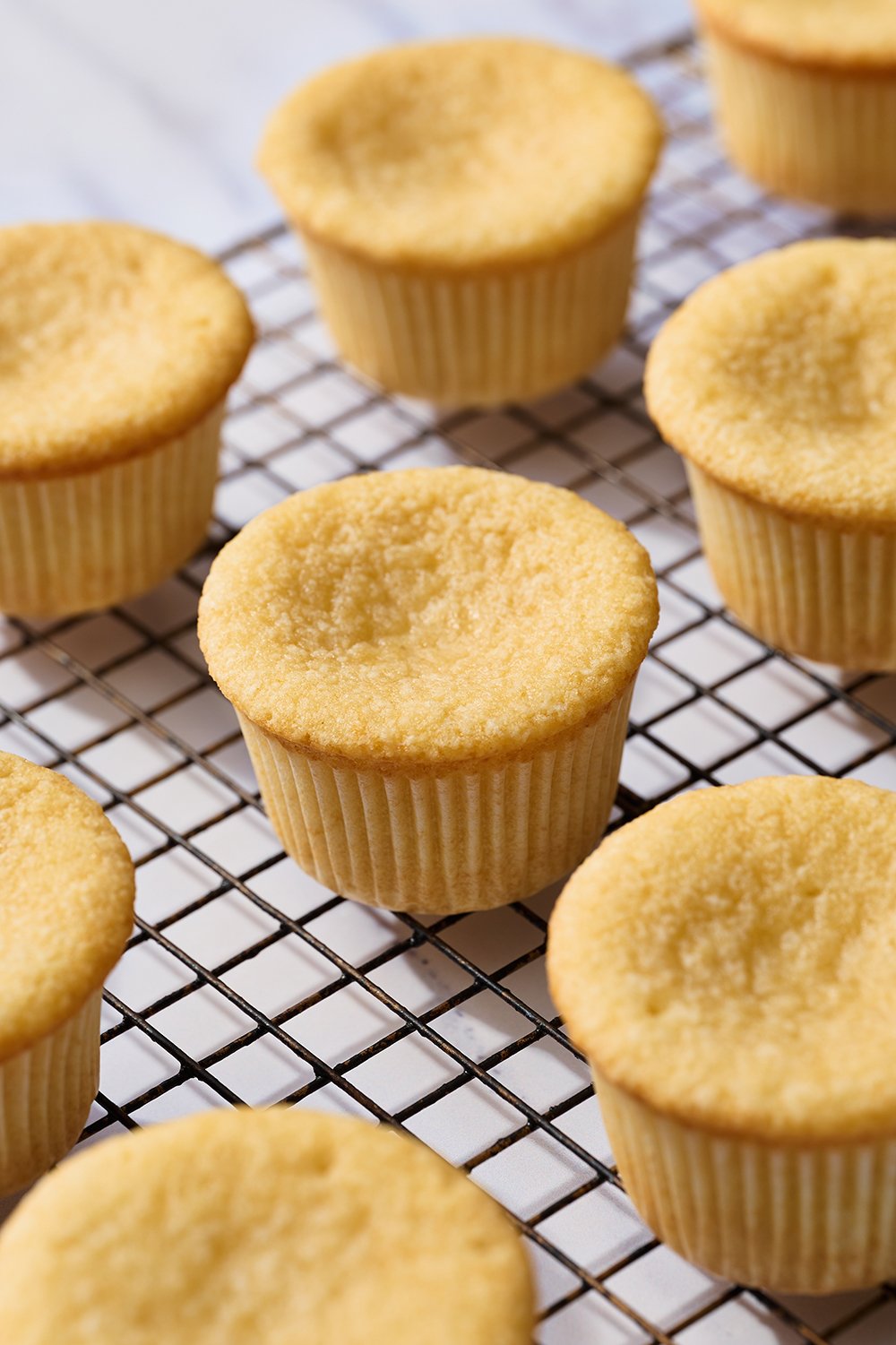
Why Did My Cake Sink in the Middle?
1. Underbaking
This is Common Culprit #1. You think the cake is baked. You’ve followed the recipe and baked for the amount of time specified. Why and how is this thing still underdone in the center?
- First and foremost, never blindly follow the recipe’s bake time. Ovens can be inaccurate and bake differently. Various styles and brands of baking pans can also bake differently. Even your altitude and climate can impact your baking time! More on ovens below. View the recipe’s recommended baking time as a starting point.
- Follow the sensory indicators. Any decent recipe will give you more indicators beyond the time it should take for your cake to bake, such as ‘until a toothpick inserted in the center comes out clean.’ Or, ‘until the edges are dry and golden brown.’ These are known as sensory indicators and should always be used in tandem with the recipe bake time.
- For total certainty, use an instant-read thermometer. Cakes and cupcakes are done when they reach an internal temperature of 205 to 210°F.

Some Helpful Sensory Indicators – How to Tell When Your Cake is Fully Baked
- A toothpick inserted into the center (all the way in – not just lightly from the surface) comes out clean. If there is any wet batter, bake a little longer.
- The baked edges of the cake have pulled away slightly from the inside of the cake pan.
- Lightly touch the top of the cake (carefully!). If it is very soft or at all loose-feeling, bake a little longer. Not all cakes will spring back when fully baked, but some will.

2. Ingredients Were Not Measured Correctly
If you’ve followed me for any length of time, you know that Handle the Heat bakers WEIGH THEIR INGREDIENTS! Volume measurements are simply not as accurate as measuring with a digital scale. This simple switch will solve 80% of your baking problems.
- All measuring cups are not created equal, so size discrepancies can occur. When measuring ingredients like flour or cocoa, it’s all too easy to pack in much more flour than the recipe writer intended.
- Incorrect measurements mean the intended ratio of ingredients is now thrown off, which impacts flavor and texture of the final product – including leading to sinkage.
- Digital scales also mean fewer dishes, so win-win!
It’s also super important to ensure you’re using the correct quantities of each ingredient.
- Read the recipe thoroughly before starting, and ensure you have all the necessary ingredients on hand and at the correct temperature.
- Adding the wrong amounts of ingredients, like adding a tablespoon of baking powder when it was supposed to be a teaspoon, can wreak havoc on a recipe.
- Substitutions can ruin a recipe. Using applesauce when the recipe writer wrote and tested the recipe using oil can severely compromise the cake’s structure, flavor, and overall quality. That’s why I’m not a fan of baking substitutions, as I discuss in this article here. This is especially true for cakes, which are more delicate and finicky.
3. Is Your Oven’s Temperature Accurate? Most Aren’t!
Most ovens are lying to us about the temperature they’re really at! Baked goods, and especially more fragile bakes like cakes, need to be baked at a correct and consistent temperature in order to develop the intended texture and structure.
- Temperature: Use an oven thermometer to ensure accuracy in temperature. They’re inexpensive and I promise they’re worth the small investment. Most home ovens are off by 15 to 25 degrees or more! More on this in my Ovens 101 article here.
- Preheating: Make sure you preheat for longer than just when the preheat beep occurs. Most ovens take at least 10 additional minutes to actually reach the specified temperature.
- Why this matters: Basically, when your oven is too hot or too cold, the air bubbles created by creaming butter and sugar fail to expand properly when exposed to the heat, resulting in a collapsed cake.
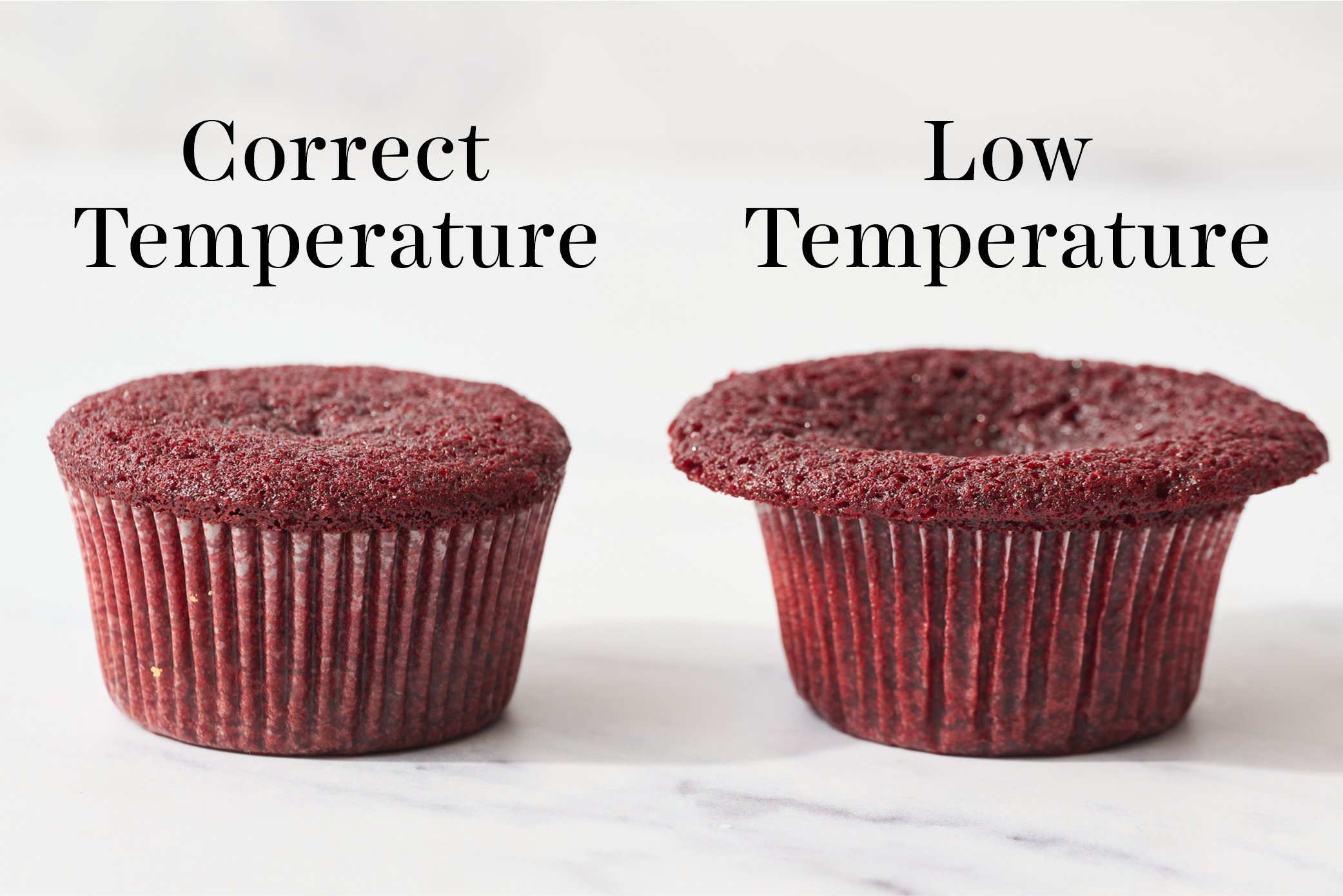

4. Be Careful Not to Open the Oven Door Too Often – and Close it Gently!
If you open and close your oven door too many times during the baking process, you’ll lose some of the heat of the oven, causing the temperature to drop. This is especially true if your oven is wider than it is deep.
- Rotating pans: Some recipes instruct you to rotate the cake pan(s) halfway through baking. Wait until the cake has set to minimize the chance of collapsing as you rotate.
- Utilize your oven’s light to avoid opening the door when checking on your cake.
- Be super careful not to slam the oven door! Slamming the door can cause the cake to collapse – as can slamming your cake pans down when removing from the oven.
5. Always Use the Correct Pan Size
Always use the pan size specified in the recipe, unless you’re prepared to experiment with bake times and know that it might not turn out perfectly the first time. A good rule of thumb is to fill a cake pan or cupcake cavity about half to two-thirds of the way full.
- Using the wrong size pan can disrupt the cake’s ability to rise and develop structure properly. This goes for the size and depth of the pan.
- Even an inch is a big difference. For example, an 8-inch cake pan holds 4 cups of batter and a 9-inch cake pan holds 5 cups of batter – that’s a 25% difference in volume!
- Using a pan that’s too small can be disastrous. This can rise and overflow in the oven, and then collapse once removed from the oven as the structure hasn’t been able to set properly.
- Pan shape matters, too. Differently-shaped pans can hold different volumes, but they can also bake differently, too. Cakes designed to be baked in an angel food pan or a bundt cake pan will often contain specific ratios of ingredients compared to sponge cakes, and if baked in an alternative pan, the cake can collapse.
- Pan type also matters. Glass, ceramic and silicone are poor conductors of heat, and can lead very easily to underbaking and therefore sinkage. I always recommend sticking with a light-colored metal pan for best results. Read more about baking in these types of pans in this article here.
- Different brands of cupcake pans can vary slightly in size, so be sure to avoid overfilling your cupcake pan’s cavities, as this can also cause overflowing and sinkage.
6. Leavening Agents
Chemical leavening agents, baking soda and baking powder, are commonly used to add height, lightness, and structure to baked goods – but issues can occur when using chemical leaveners.
- Expired: If your baking soda or powder is expired, this can cause your cake to sink in the center. Note: they can expire or lose their effectiveness before the expiration date printed on the packaging. Learn how to test your baking soda and powder for freshness here.
- Too much: If you accidentally overmeasure your baking soda or baking powder, this can also cause your cake or cupcakes to overexpand in the oven, then sink in the middle upon cooling.
- Substituting: It’s important to note that baking soda and baking powder work differently on a chemical level and are not interchangeable. Make sure to use the correct leavener called for in your recipe.
- High altitude: If you’re baking at a higher altitude, you’ll need less leavening to achieve the same result as sea level. Without proper altitude adjustments, your products may sink. King Arthur has a great article on baking at high altitudes and how to adjust for this.
7. Overbeating, Overmixing, or Undermixing Your Cake Batter
Mixing properly can be a tricky dance. You need to incorporate enough air during the creaming process to achieve a light and fluffy cake, without over or undermixing.
- Incorporate too little air and your cake won’t rise enough.
- Too much air and your cake will collapse because it simply can’t hold onto all that air.
- Overbeating can add too much additional air and/or large air bubbles which the cake can’t support, causing it to collapse in the oven.
- Beat your butter and sugar gradually at medium to medium-high speed. Don’t beat too aggressively; creaming can’t be rushed, as the air needs to be incorporated gradually.
- It’s important to pay more attention to sensory indications when creaming than exact time parameters. The temperature of your ingredients, size and shape of your mixing bowl, and the speed and power of your electric mixer will all influence the creaming time.
- Always be cautious once you add the eggs, and even more cautious once the dry ingredients are added. Overbeating these ingredients can create a tough, rubbery texture to the final product, and, if the structure is built improperly, this can also cause your cake or cupcakes to sink.

8. Your Ingredients Are Not At The Right Temperature
Most ingredients used in cake batter should be room temperature, and your recipe will likely specify this – but what does ‘room temperature’ mean?
- Typically, ingredients should be a cool room temperature – about 67°F.
- Much warmer or colder than this, and the ingredients cannot mix and emulsify properly.
- If the ingredients do not emulsify as they should, this can prevent the cake from forming its structure appropriately, and cause unpleasant textures, pockets of unincorporated ingredients, and sinkage.
- If your recipe doesn’t specify a temperature for an ingredient, it’s typically safe to assume a cool room temperature of about 67°F will work well. About 30-60 minutes out of the fridge should be perfect, depending on the ambient temperature of your kitchen.
Additional Tips:
- Bake your cake immediately after mixing the batter, especially if it contains baking soda. The longer the batter sits, the less leavening effect it will have.
- Preheat the oven before you start the batter, to give it plenty of time to appropriately preheat, before the cake is ready to bake.
How to Salvage Sunken Cake and Cupcakes
Can I Put My Sunken Cake Back in the Oven?
If you notice quickly that your cake is underbaked, you can pop it back into the oven to finish baking. This will not ‘fix’ the sinkage or help it rise any further, but it may help salvage the inedible center of the cake. This needs to be done quickly, however. Putting a cold cake back in the oven will just overbake and dry out the edges before the center bakes through any further.
How Can I Salvage My Sunken Cake?
There’s no need to chuck the whole thing, as long as it tastes good and is cooked through! Here are some ideas for how to salvage your sunken cakes, depending on the severity of the sinkage.
Minor Sinking:
Just use your buttercream to level out the cake!
- Place one layer sunken-side up.
- Use a generous amount of frosting for the filling.
- Place the second layer flat side up.
- No one will notice a thing!

Moderate Sinking:
If your cake is noticeably sunken in the center but is cooked through, use a cake leveler to even it out.
- A cake leveler makes quick and easy work of creating a perfectly level, even cake layer.
- If you don’t have one, you can also use a serrated knife. Slice carefully and evenly to level out the cake layer.
Major Sinking:
If your cake has completely collapsed and is raw or underdone in the center, there are still a few options to salvage it.
- Use a paring knife or large round cookie cutter to remove the sunken center.
- Fill the empty middle with fruit, candies, or buttercream for a ‘surprise inside’ cake!
- Alternatively, cut the cooked sections of the cake up into cubes and make a trifle.
- Or mix with some buttercream, roll into balls, and coat in chocolate to make cake pops.
More Baking Science Articles:
Photos by Joanie Simon.

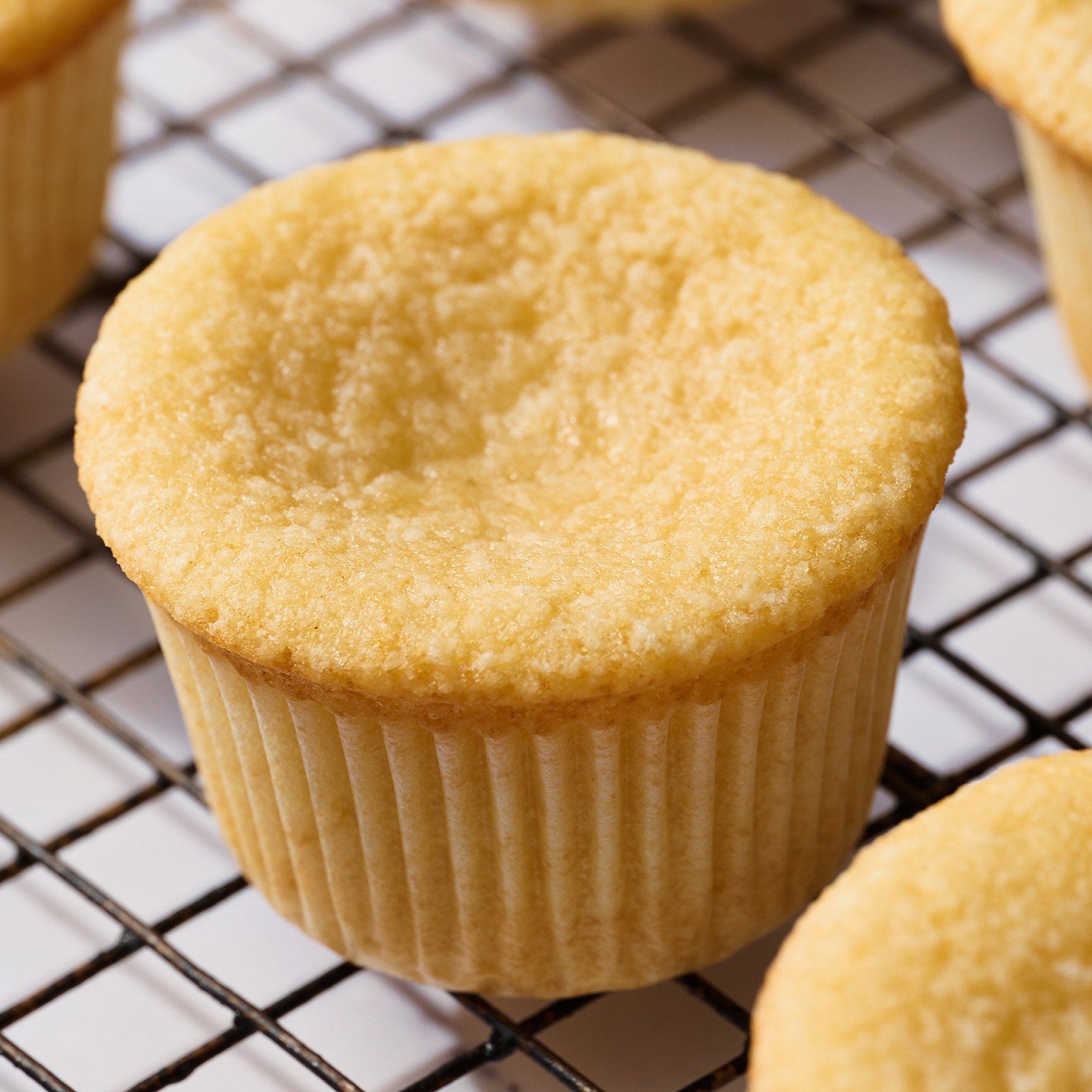

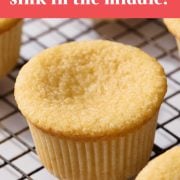



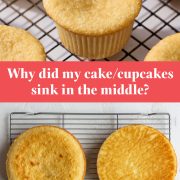




















How do you insert the instant read thermometer to get the internal temperature of the cake? I want to make sure it can be removed without leaving a noticeable hole (even it I frost over it, I don’t want someone to see a tunnel in their piece). I’d like to use the Square Dot from ThermoWorks so I don’t need to open the oven door but I don’t know how I could put it in the cake batter without it resting against the pan. Thank you! I thought I had to buy a new oven, but your tips were really helpful.
Hi Michelle! To check if a cake is done, insert a digital food thermometer into the center since the edges bake faster. Thermometers like the Square Dot are best for meats, not cakes, because you can keep the thermometer inserted the entire time its baking. If you left a thermometer in a cake, it’d more than likely result in sinking/collapsed cake when taken out. A digital thermometer won’t leave a big hole, and once frosted, it’ll be unnoticeable. Just be sure to insert it gently and keep it still (don’t wiggle it around) to avoid any tunnels. Hope that helps!
That does help. Thank you! At what point would you check the internal temperature? Trying to avoid opening the oven door or taking out the cake unnecessarily.
Thanks guys!
Fantastic information! I love your site, so helpful. Thank you